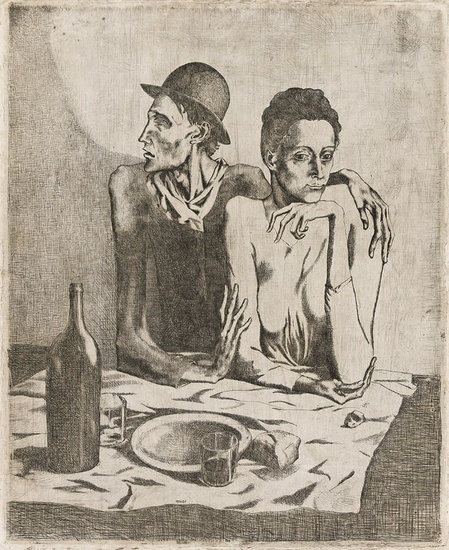PABLO PICASSO Le Repas Frugal.
PABLO PICASSO
Le Repas Frugal.
Etching and drypoint, 1904. 463x377 mm; 18¼x14¾ inches, narrow to small margins. Edition of 250. Printed by Louis Fort, Paris. Published by Vollard, Paris. From La Suite des Saltimbanques. A very good, dark and evenly-printed impression of this early, important print, with strong contrasts.
The austerity and sentimentality of Le Repas Frugal is characteristic of Picasso's (1881-1973) Blue Period (1901-04). During his Blue Period and into his Rose Period, so-called for the principal color palettes that he utilized in his paintings at the time, Picasso's art explored the experiences of those on the fringes of society and those in the poor, bohemian neighborhoods of Spain and Montmartre, Paris, where the artist resided in the early 1900s. Picasso's budget was so limited that he purchased the plate for Le Repas Frugal second-hand (it had been a horizontal landscape etching)—the remnants of the previous etching can be seen in the foliage ghosting through the background in the upper right of the print. After rudimentary instruction in the art of printmaking and having completed just one other print in 1899, Picasso executed this large, ambitious etching of an emaciated, meditative couple and their sparse meal.
During his Blue Period, Picasso utilized Mannerist techniques in his execution of figures; the elongated forms and compositional tension of Mannerism highlights the isolation and austerity of Picasso's subjects. However, the flatness of the scene, the stylized facial features of the woman and the painstaking detail in the hands of the couple indicate that this is not a scene taken from life, but an allegorical scene constructed from the glimpses into the lives of those living in poverty. This is the impact of the Symbolist aesthetic, which encouraged the evocation of emotions over realism and elevated quotidien scenes.
Though this plate was completed in 1904 and Picasso made some initial proofs, it wasn't published as an edition until 1913 when Picasso's then art dealer, Ambroise Vollard, purchased the plate and steel-faced it. This print is part of La Suite des Saltimbanques, along with 11 drypoints and 2 additional etchings created by Picasso between 1904-06. Bloch 1; Geiser 2.
Sale price
Estimate
Reserve
Time, Location
Auction House
PABLO PICASSO
Le Repas Frugal.
Etching and drypoint, 1904. 463x377 mm; 18¼x14¾ inches, narrow to small margins. Edition of 250. Printed by Louis Fort, Paris. Published by Vollard, Paris. From La Suite des Saltimbanques. A very good, dark and evenly-printed impression of this early, important print, with strong contrasts.
The austerity and sentimentality of Le Repas Frugal is characteristic of Picasso's (1881-1973) Blue Period (1901-04). During his Blue Period and into his Rose Period, so-called for the principal color palettes that he utilized in his paintings at the time, Picasso's art explored the experiences of those on the fringes of society and those in the poor, bohemian neighborhoods of Spain and Montmartre, Paris, where the artist resided in the early 1900s. Picasso's budget was so limited that he purchased the plate for Le Repas Frugal second-hand (it had been a horizontal landscape etching)—the remnants of the previous etching can be seen in the foliage ghosting through the background in the upper right of the print. After rudimentary instruction in the art of printmaking and having completed just one other print in 1899, Picasso executed this large, ambitious etching of an emaciated, meditative couple and their sparse meal.
During his Blue Period, Picasso utilized Mannerist techniques in his execution of figures; the elongated forms and compositional tension of Mannerism highlights the isolation and austerity of Picasso's subjects. However, the flatness of the scene, the stylized facial features of the woman and the painstaking detail in the hands of the couple indicate that this is not a scene taken from life, but an allegorical scene constructed from the glimpses into the lives of those living in poverty. This is the impact of the Symbolist aesthetic, which encouraged the evocation of emotions over realism and elevated quotidien scenes.
Though this plate was completed in 1904 and Picasso made some initial proofs, it wasn't published as an edition until 1913 when Picasso's then art dealer, Ambroise Vollard, purchased the plate and steel-faced it. This print is part of La Suite des Saltimbanques, along with 11 drypoints and 2 additional etchings created by Picasso between 1904-06. Bloch 1; Geiser 2.



